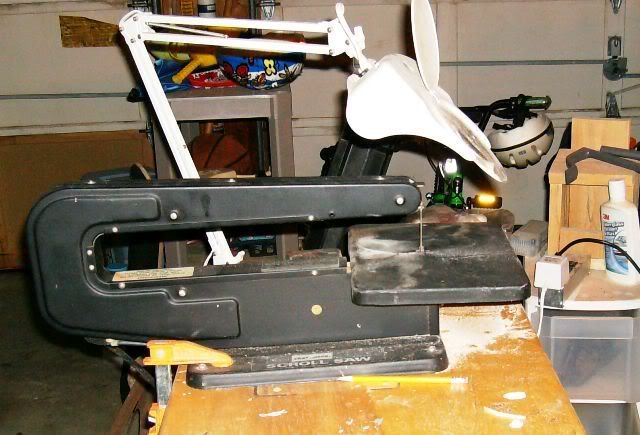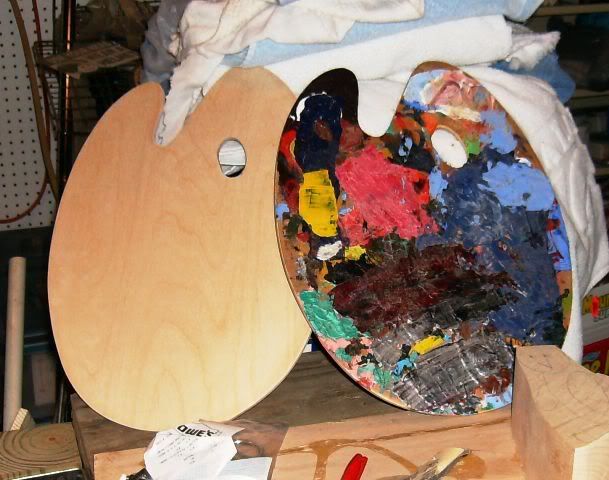I got the "fine" pinned blades that I will use with this saw:

to cut sound holes in sound boards for instruments.
I figured I should do some test cutting to see how well they worked and to brush a little rust off the operator. My oldest daughter had given me a paint palette to "clean off" and I haven't gotten around to it yet. I had some ply that Sawduster gave me (Thanks!! :eusa_danc) that was the perfect thickness and width for tracing a new one instead of cleaning the old one and it would give me something to mess around with that has a pretty wide margin for errors. So I made a new one:

It started out a little rough, but I made adjustments. The single high speed of the saw caused too much vibration and made it hard to track well and the tilt lock nut would loosen ant the table would get unstable. So I tried the foot control for my hanging motor rotary carver with it. Works like a champ! I tightened the tilt nut and went back at it and could track much better and got a pretty good arc. Then I learned the trick of feeding the blade through the hole on a pinned saw- it's actually easiest to just take it off,position the hole over table's blade slot and put the blade back on. It's not that hard to get the blade in the slot and the pins to catch even doing it blindly through the board.
After cutting that, I trimmed one of my soundboards that had a lot of excess width. It's very thin spruce. I am very glad I put the speed control on - it needs a very slow speed and then it is easy to track and cut a clean line. It will cut a pretty tight circle also. Maybe tomorrow night I will cut sound holes...

to cut sound holes in sound boards for instruments.
I figured I should do some test cutting to see how well they worked and to brush a little rust off the operator. My oldest daughter had given me a paint palette to "clean off" and I haven't gotten around to it yet. I had some ply that Sawduster gave me (Thanks!! :eusa_danc) that was the perfect thickness and width for tracing a new one instead of cleaning the old one and it would give me something to mess around with that has a pretty wide margin for errors. So I made a new one:

It started out a little rough, but I made adjustments. The single high speed of the saw caused too much vibration and made it hard to track well and the tilt lock nut would loosen ant the table would get unstable. So I tried the foot control for my hanging motor rotary carver with it. Works like a champ! I tightened the tilt nut and went back at it and could track much better and got a pretty good arc. Then I learned the trick of feeding the blade through the hole on a pinned saw- it's actually easiest to just take it off,position the hole over table's blade slot and put the blade back on. It's not that hard to get the blade in the slot and the pins to catch even doing it blindly through the board.
After cutting that, I trimmed one of my soundboards that had a lot of excess width. It's very thin spruce. I am very glad I put the speed control on - it needs a very slow speed and then it is easy to track and cut a clean line. It will cut a pretty tight circle also. Maybe tomorrow night I will cut sound holes...
